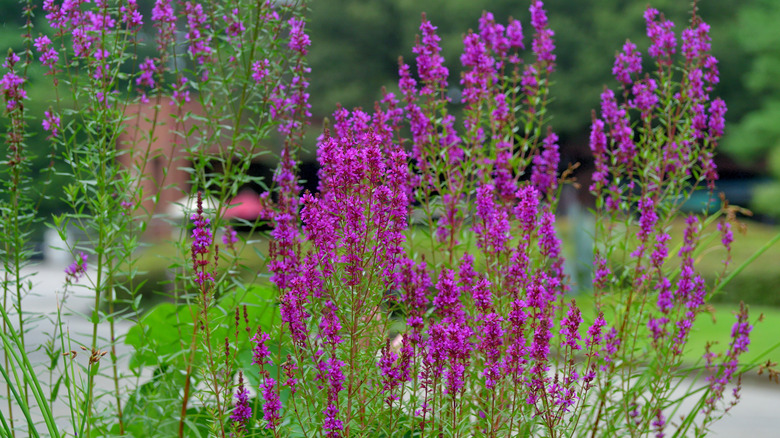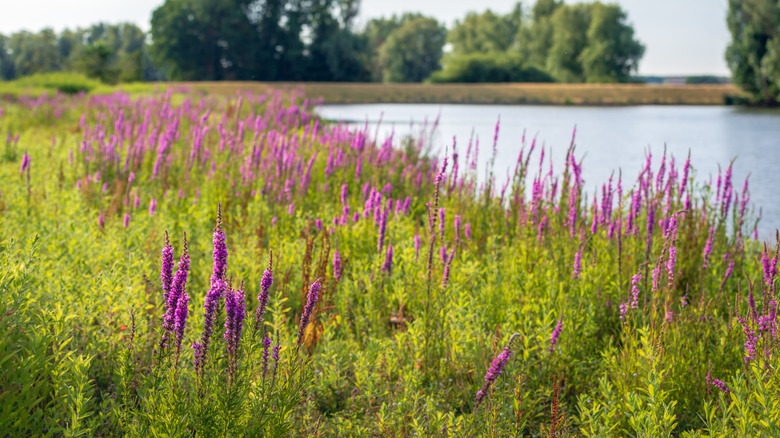The Purple-Flowering Perennial Plant You'll Wish You Never Grew In Your Yard
Ever looked at something pretty and thought "That's a great idea for me!" ... even though you know you'll regret it later? Outside of the dating world, or some questionable wardrobe choices, this can also apply to landscaping. Sometimes our choices are led by our eyes and by our hearts, and not by practical, rational thought. Consider, for example, a beautiful plant featuring tall wand-like stems crowded with vibrant flowers called purple loosestrife (Lythrum salicaria). It seemed like a good idea at the time!
In hindsight, however, this plant should go on your no-grow list. Turns out, this blossoming beauty is an invasive garden plant to avoid. If you're not familiar with the term, an invasive species is defined by the United States Department of Agriculture as a plant which is "non-native (or alien) to the ecosystem," and in their words, one "whose introduction causes or is likely to cause economic or environmental harm or harm to human health."
What, this little thing is that bad? Yes, the purple loosestrife can, and does, cause strife.
The problem with this purple plant
First, understand that not all non-native species are necessarily bad. Many plants and crops that are important to our health and livelihood have been imported from other lands. Crops like tomatoes and bell peppers did not originate in North America, but they're not causing harm and are, in fact, beneficial. Therefore, they are termed "non-native" rather than "invasive." Not so with the pretty purple loosestrife. This is, by all categories, considered a non-native and invasive species capable of causing harm. In fact, it's so bad that it made it onto 100 of the World's Worst Invasive Alien Species, a list by the World Conservation Union ... and this list includes animals, too!
Purple loosestrife first arrived in the Americas sometime in the 1800s when it's believed that it was unwittingly carried over from Europe and Asia in dirt on the outside of ships. It's also possible that it was brought over intentionally as an ornamental shrub. Despite its humble beginnings, it's now been spotted in 43 of the 49 continental United States and in much of Canada.
The main issue with purple loosestrife is how aggressively it grows and how quickly it spreads. Not only that, but it crowds out important native species. This perennial herb grows best in wet areas like marshes, ditches, the edges of lakes, and along the banks of streams and rivers. However, because it grows so invasively, it affects the ecosystem by outcompeting native grasses and plants that are needed to keep the area healthy and feed local wildlife. It can also reduce important bird habitat.
How can you keep purple loosestrife out of your life?
The first and most obvious answer for how to keep purple loosestrife away is not to purchase or plant it. There is a "sterile" version of this plant, but it has also been found to spread, so best to steer clear of it altogether. If you do identify it in your yard or any nearby areas, you can report it using the Early Detection & Distribution Mapping System (EDDMapS), a web-based mapping system designed specifically for identifying and reporting invasive species. You can also report it by calling your state's Department of Agriculture or a local university agricultural extension. These entities are best equipped to give you instructions on how to eradicate the plant safely.
If you're still looking for a pretty perennial plant for your yard, there are many fine alternatives to purple loosestrife that grow well in wet areas. One favorite is swamp milkweed (Asclepias incarnata), which also has a pretty pink color and attracts pollinators. Another choice would be Joe-pye weed (Eutrochium fistulosum), which can grow up to seven feet tall with tiny, pinkish-purple blossoms at the ends. Or try any of the many types of purple flowering vines.
Whichever pretty plant you choose, consider the saying, "Beauty is only skin deep, but deception goes right to the core." Why, purple loosestrife, why? Your beauty is so deceiving. Swipe left.


